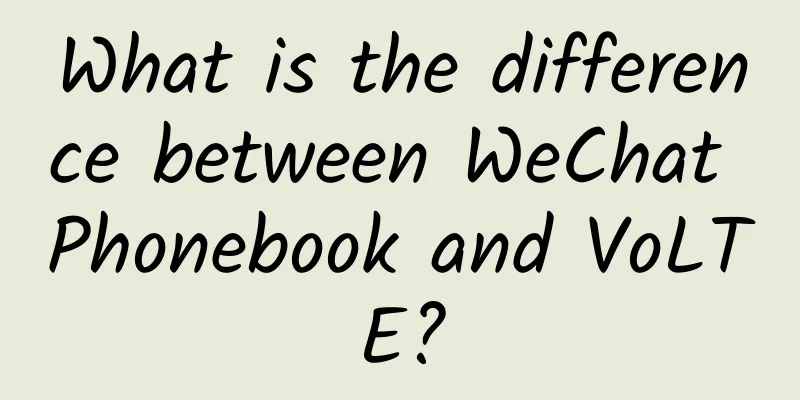What is the difference between WeChat Phonebook and VoLTE?

|
WeChat Phonebook is now online! How big of an impact will it have on operators? Let's put this question aside for now. As a communications engineer, I want to analyze the difference between the two from a technical perspective. My conclusion is: VoLTE wins! However, technology does not necessarily win the market, and what will the future hold? It is still unknown. At first glance, there is no difference between the two. VoLTE is the next generation of wireless voice technology, and it looks a lot like VoIP over wireless. In a way, it is the same, transmitting voice over IP packets. But technically, it is not exactly the same. First of all, we need to understand one difference: VoLTE is a voice service based on IMS (IP Multimedia Subsystem), rather than on traditional IP networks (such as the Internet). It is built on the operator's network, which means that the operator can provide a higher level of control and management for VoLTE. WeChat Phonebook, like other OTT VoIP, is an overlay VoIP technology that relies on the Internet to deliver data packets. The problem is that the Internet delivers data packets with a consistent "best effort" attitude: all you can do is send the data packets to the cloud, and the rest is just a matter of prayer. Another key word is QoS (Quality-of-Service). QoS is the most familiar keyword to the communication industry, and countless communication professionals have been working for it for many years. QoS describes transmission delay, reliability, and data integrity. In order to provide a higher level of QoS, operators must control and manage each link of each end-to-end service connection, which is something that Internet-based OTT VoIP cannot do. So, what improvements have communications engineers made to VoLTE VoIP around this QoS? VoLTE is a standard LTE voice solution defined by GSMA and a standard protocol has been developed. The standard specifies four major technical features of VoLTE, which ensure that VoLTE provides high-standard QoS: 1. Semi-persistent scheduling (SPS) 2. TTI bundling 3. Discontinuous reception 4. Packet header compression RoHC 1. Semi-persistent scheduling Unlike data packets, voice packets are small and sent frequently. When LTE sends data packets, physical resource blocks (PRBs) are allocated for both uplink and downlink, which consumes more wireless resources for small and frequently sent voice packets. To solve this problem, VoLTE introduces semi-persistent scheduling. Semi-persistent scheduling is a more flexible resource scheduling method. For example, in a voice conversation, a voice packet is sent every 20ms. During the silent period, there is no voice data transmission, only background noise, and the PRB resource allocation is canceled. In the uplink direction, the resource allocation can be canceled by defining how many empty data packets are received; in the downlink direction, the network sends a radio resource control (RRC) message to cancel it. 2. TTI (Transmission time interval) bundling LTE performs resource scheduling once per TTI. To reduce latency, the basic unit of physical layer scheduling in LTE is 1ms, which means that HARQ must confirm transmission once per second. However, at the edge of some cells, where coverage is limited, the UE is limited by its own transmission power. Within a 1ms time interval, the mobile phone does not have enough time to complete a complete voice packet reliable transmission. The solution is to bundle multiple consecutive TTIs together. There is no need to wait for HARQ feedback for each TTI. A VoIP data packet is sent in the bundled consecutive TTIs, and HARQ feedback is only required after the last transmission of the bundle is completed. 3. Discontinuous Reception (DRX) Keeping a call will consume a lot of power. Since VoLTE traffic is predictable (20ms data packets), the UE does not need to monitor the physical control channel at all times. The UE reception can be turned off during the call until the voice packet arrives, which can save power. 4. Robust header compression RoHC For VoLTE, the IP header is too large, which seriously wastes air interface resources. For example, a combined RTP, UDP and IP header is 40-60 bytes in size. After 14.4kpbs AMR-WB encoding, the data payload of each 20ms frame is about 50 bytes. RoHC header compression can compress it to 2-4 bytes for more efficient transmission on the air interface. In theory, VoLTE can provide higher quality voice services thanks to the adoption of these technologies. In practice, this is also the case. According to Nokia Smart Labs test results, VoLTE saves 40% more power and data than OTT VoIP. Under the premise of the same voice quality, most OTT VoIP applications consume 20% to 40% more data than VoLTE during calls. In addition, because VoLTE voice calls are carried on GBR (GBR refers to the minimum bit rate guaranteed by the system. Even when network resources are tight, the corresponding bit rate can be maintained. On the contrary, Non-GBR means that when the network is congested, the service (or bearer) needs to bear the requirement of reducing the rate. Since Non-GBR bearers do not need to occupy fixed network resources, they can be established for a long time. GBR bearers are generally established only when needed.), VoLTE can provide consistent service quality even when network resources are tight. However, OTT VoIP is not so lucky. According to the test results of Nokia Smart Labs, in a network environment with high Non-GBR traffic, the call drop rate of OTT VoIP is as high as 100%; in a network environment with medium Non-GBR traffic, the call drop rate of OTT VoIP can reach 65%, while VoLTE always maintains a 0% call drop rate. Similarly, as the network load increases, the voice quality of OTT VoIP decreases significantly, while VoLTE always maintains high-quality voice. I personally think that these four technologies and IMS are the key differences between VoLTE and WeChat Phonebook (or other OTT VOIP). But in fact, they are not as simple as I make them out to be. Because of QoS and standards, operators need to spend a lot of manpower, material resources and financial resources to deploy VoLTE, and some operators even regard this as a sunk cost. Not only that, a lot of testing and optimization work must be done later to ensure and improve QoS. Regardless of whether it is worth it for operators to pay such a high price, it is undoubtedly a good thing for users. Because it is precisely these unique technical features of VoLTE that enable VoLTE to provide a truly "carrier-grade" service experience. Compared with OTT & VoIP, VoLTE has many advantages and disadvantages. Complex deployment, lack of flexibility, complex billing, high construction costs, interoperability issues, etc. are all challenges faced by VoLTE. This makes VoLTE have no advantage in price competition. If the cost determines the price of a product, if the cost of a product is almost zero, then they can fight with their opponents without scruples, unless the operator really shows the determination to cut off the arm of a hero. For operators, this is a necessary step. Operators have always used "retrograde" technology to deal with voice problems, and today they finally tasted the bitter fruit. Faced with the challenges from Internet giants today, the only thing operators can do is to catch up. Once they lose this piece of cake, they will lose the opportunity to push their brands to the forefront and gradually become "pipeline providers" for traffic. Not only will they lose their brand influence, but they will also be gradually marginalized by users. No one cares which company provides the tap water at home? This tap water company has never had any brand! As a winner of Toutiao's Qingyun Plan and Baijiahao's Bai+ Plan, the 2019 Baidu Digital Author of the Year, the Baijiahao's Most Popular Author in the Technology Field, the 2019 Sogou Technology and Culture Author, and the 2021 Baijiahao Quarterly Influential Creator, he has won many awards, including the 2013 Sohu Best Industry Media Person, the 2015 China New Media Entrepreneurship Competition Beijing Third Place, the 2015 Guangmang Experience Award, the 2015 China New Media Entrepreneurship Competition Finals Third Place, and the 2018 Baidu Dynamic Annual Powerful Celebrity. |
<<: Google Android 5.0 gets a wake-up call
>>: Microsoft finally fixes Windows 95 vulnerability
Recommend
Don't be a leader who is overwhelmed, a private lesson on management with an annual salary of one million
[Private management lesson for those with an annu...
How does the financial industry play with information flow? Information flow advertising on a P2P platform
As an innovative financial organization model, P2...
The first "miracle drug for myopia" in China has been approved for sale! Please note that it can't be used just because you are myopic
The latest information on the official website of...
Are you tired and annoyed about cleaning before the New Year? Here are three steps to make it easy!
As the year draws to a close, one thing every hou...
How to improve customer acquisition efficiency and achieve 10 times conversion rate within 150 days?
Many friends who work in P2P would say that there...
Smart investment advisors, asset allocation, content marketing…How are financial management platforms transforming in 2017?
After briefly summarizing the background of indus...
"In the Name of People" has 100 articles with over 100,000 views. Here are 4 universal tricks to follow the trend.
Since its launch on March 28, the WeChat index of...
Microplastics found in human blood for the first time, may have spread all over the body! These are possible sources...
Expert: Yu Xiaoxuan, PhD student, School of Envir...
APP marketing methodology: event marketing, down-to-earth, and learning from each other's strengths and weaknesses
For a business, there are too many ways to promote...
Why does China's most festive fruit unify the winters of the north and south?
Every winter, if there is no hawthorn, it seems i...
Shine! Chinese Treasures ①丨The history of "China" is longer than you think
The word "China" refers to both China a...
7.9 seconds to reach 100 km/h, maximum range 375 km! This is the only pure electric four-wheel drive SUV you can buy for 300,000 yuan
It is obvious that Chinese car consumers prefer S...
Cool elastic menu, with horizontal and arc
Source code introduction Cool elastic menu, with ...
How to plan a lottery event to improve user experience?
Treat the activity as a product. Every change and...
"Tik Tok Video Good Things Sharing Practical Course" 0 fans + disassembly + mid-term + post-term
"Douyin Video Good Things Sharing Practical ...









